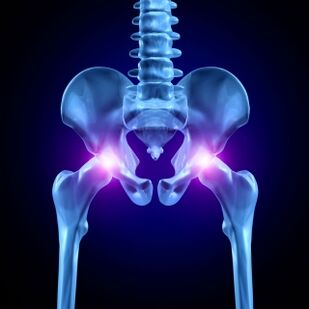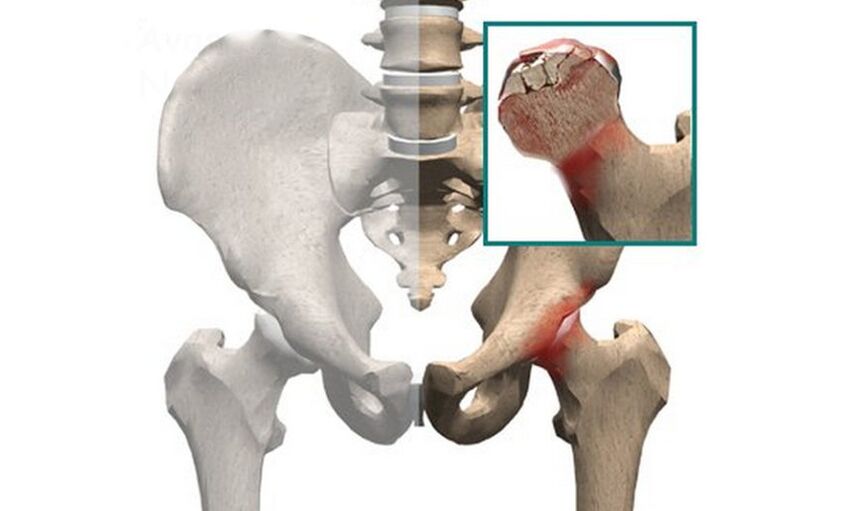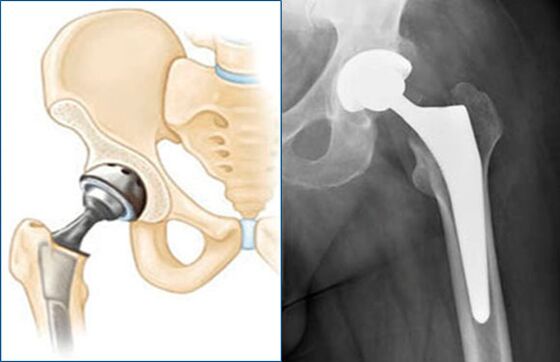The hip joint is the largest joint in the human body. Every day he makes thousands of movements while walking, running, climbing stairs and exercising. Constant loads, inflammatory processes, injuries and illnesses can cause coxalalgia - pain in the hip joint. It is necessary to establish the cause of its occurrence as quickly as possible to avoid limitation of mobility and disability.
Classification of pain sensations

During a visit to the doctor, it is necessary to describe in detail the nature of the pain: the degree of its severity, intensity, frequency - the accuracy of the diagnosis depends on this. Depending on the nature of the pain, it may be:
- Spicy.In this case, the pain is intense, even unbearable. It can appear suddenly and also disappear suddenly. As a rule, a patient with acute pain can quite accurately indicate the area of its location. Acute pain can radiate, spreading to areas closest to the origin of the pathology.
- Aching.The pain is not that intense, sometimes it can be felt as discomfort and does not have an exact location. The aching pain may intensify during movement or after exercise and disappear for a while.
- Chronicle.This category generally includes pain that occurs with varying regularity for more than six months. Chronic pain is generally the most difficult to treat.
Possible sources of pain
The main causes of pain in the hip joint are:
- injuries,
- infectious diseases,
- inflammatory processes,
- degenerative tissue changes,
- developmental pathologies of the musculoskeletal system.
Injuries
With traumatic damage to the hip joint and femur, pain occurs immediately, accompanied by redness and swelling of tissues, limitation of limb mobility and the formation of extensive bruises. Depending on the severity of the injury, the pain may be more or less intense.
If you crash or fall on your side, soft tissue bruising may occur. It is characterized by the formation of bruises, the pain at the site of the injury intensifies upon palpation. Unlike a dislocation and a fracture, with a contusion there is no restriction in the mobility of the injured leg, there are no visually discernible deformities and the limb fully retains its functions.
Dislocation of the hip joint in a healthy person can only occur under very strong physical impact, for example, when falling from a great height or in a car accident.
The limb takes a forced rotational position, more often inward, less often outward. The pain is intense, accompanied by swelling, numbness (if the nerves are affected), the victim is unable to move the injured limb.
Femoral neck fracture
The cause of pain in the hip joint can be a violation of the integrity of the femoral neck - an injury that mainly affects older women who have crossed the 60-year threshold. Hormonal and age-related changes in the body after menopause accelerate the calcium leaching process, making bones fragile and brittle even with less exposure. A fall, a bruise or even a careless movement can lead to a fracture of the femur at its thinnest place, where the diaphysis connects to the head embedded in the hip joint.
Symptoms of a hip fracture are:
- pain in the pelvic region, radiating to the groin and lower back, aggravated by tapping the heel;
- shortening of the injured leg;
- limited mobility, inability to lean on the injured leg;
- external rotational position of the limb;
- "Stuck heel" syndrome – the inability to lift the straight leg from the surface from a lying position.
A fracture of the femoral neck can be impacted - in this case, the bone fragments stick together. In this case, the functions of the limb can be partially or even completely preserved, but when the fragments are crushed, signs of injury will appear in full. Such an injury requires immediate intervention, so if you suspect a fracture, seek medical help as soon as possible.
Inflammatory processes
One of the main causes of Coxalgia is inflammatory processes in the tissues of the joint or its surroundings.
Arthritis is the inflammation of the cartilage tissue of the joint. The causes can be infections, chronic injuries, metabolic disorders, excessive stress, systemic connective tissue diseases. Symptoms of the disease, in addition to pain, which intensifies after exercise or at night, are redness and swelling of tissues in the region of the affected joint, a local increase in temperature and limited mobility of the leg.
Rheumatoid arthritis is a systemic connective tissue disease of an autoimmune nature. Women are more susceptible to the disease. It affects small and large joints, usually paired. Symptoms characteristic of rheumatoid arthritis:
- joint pain, worse at night and lessening after movement;
- formation of subcutaneous compactions in the area of the affected joint, so-called rheumatic nodules;
- redness, swelling and local increase in temperature in the affected joints.
Bursitis is an inflammatory process that develops in the synovial bursa of a joint, accompanied by a pathological accumulation of exudative fluid in the joint tissues. The main causes of the development of the disease are injuries, excessive physical activity, infections and complications of arthritis of various etiologies. Bursitis pain occurs deeply, spreading to the outer surface.
Ankylosing spondylitis is an idiopathic disease, that is, the exact causes of its occurrence in most cases cannot be established. It is assumed that the pathology is genetically determined and hereditary predisposition plays an important role in its development.
Most often, the manifestation of the disease occurs at the age of 20-30 years, its first symptoms are pain in the lower back, hips and buttocks, worsening at night, stiffness, rapidly developing ankylosis - immobility of the joints. In later stages, if left untreated, the disease causes severe deformation of the joint tissue, leading to profound disabilities.
Degenerative changes in tissues
Coxarthrosis, or osteoarthritis of the hip joints - a degenerative change in cartilaginous tissue - is a common cause of Coxalgia in people over 40-45 years of age. The disease is chronic and progressive. The causes of its development are considered chronic injuries, hereditary predisposition, age-related changes and concomitant inflammatory diseases of the joints. In young people, the development of coxarthrosis may be due to congenital dysplasia of the hip joint.
Symptoms of pathology:
- pain in the groin, lower back, buttocks, thigh, increasing with movement and decreasing at rest;
- muscle weakness;
- intermittent claudication, "duck" gait with bilateral joint damage;
- limb dysfunction, difficulties with abduction, adduction, rotation.
Infectious diseases
Infectious arthritis, which is also a common cause of Coxalgia, can develop as a result of pathogenic microorganisms entering the joint tissue from a distant focus of a viral or bacterial infection through the bloodstream. It can be caused by streptococci, staphylococci, Pseudomonas aeruginosa and tuberculosis bacilli, pale spirochetes, influenza viruses and other agents.
With infectious arthritis, joint pain is accompanied by redness and swelling of surrounding tissues, as well as general symptoms - fever, malaise and weakness.
Other reasons

In addition to injuries, inflammation and infections, hip joint pain can be caused by:
- Innervation disorders.Inflammation and compression of the nerve roots, particularly the sciatic nerve, can cause pain in the hip, inguinal triangle, and buttocks.
- Formation of neoplasms, including malignant ones, in the tissues of the joint and its surroundings.
- Aseptic necrosis of the femoral head.Chronic poor circulation in tissues causes degenerative changes in cartilage and bone tissue, which can lead to the total destruction of bone structures.
- Juvenile epiphysiolysis.Chronic pain in the hip joint in children and adolescents can be caused by the development of epiphysiolysis, a pathological displacement of the femoral head caused by hormonal disorders in the body. Boys are more susceptible to the disease, but in rare cases it is also diagnosed in girls. As a rule, pathology is accompanied by delays in sexual development and endocrine disorders.
Hip joint pain is a common occurrence in women in the third trimester of pregnancy. Causes of Coxalgia in Pregnant Women:
- increase in body weight and change in the center of gravity, redistribution of the load on the musculoskeletal system;
- natural hormonal changes: shortly before giving birth, a woman's body begins to produce a hormone that relaxes the ligaments;
- pressure of the enlarged uterus on large vessels and nerves, disruption of innervation and blood circulation in the pelvic organs and lower extremities;
- calcium deficiency in the body of the expectant mother.
If the pain during pregnancy was caused by the above factors, then a few weeks after birth they should disappear without a trace. If, a month after the birth of the child, the pain is still present, you should consult a doctor.
Alarming symptoms
Pain in the hip joint is an alarming symptom, a mandatory reason for a doctor's consultation. The sooner the cause of Coxalgia is identified, the greater the likelihood of a complete cure. However, there are cases in which seeking medical help must be immediate:
- pain in the joint region occurs after a fall, blow, bruise or any other injury, while the mobility of the limb is impaired;
- the tissues around the joint become red and swollen, and the general body temperature rises to feverish levels (38 and above);
- there are problems with defecation and urination.
Diagnosis
The first step in determining the cause of hip pain is to see a doctor. The surgeon or orthopedist will take an anamnesis, find out the nature of the pain, the frequency and degree of its manifestation, and also examine the patient to assess the mobility of the joint and the condition of the tissues surrounding it. To make an accurate diagnosis, laboratory and instrumental diagnostic methods can be prescribed:
- general, biochemical, serological and immunological blood tests;
- x-ray of the pelvic bones, thighs, hip joints;
- ultrasound examination of the tissues of the joint and the tissues surrounding it;
- magnetic resonance imaging and computed tomography to obtain an accurate three-dimensional image of the affected area;
- endoscopy of the joint with a probe inserted into its cavity;
- puncture to study effusion - pathological fluid accumulated in the joint capsules;
- tissue biopsy.
Treatment methods
Treatments for conditions that cause hip pain depend on the underlying cause. In cases where the pain was caused by injury, the main method of conservative treatment will be joint immobilization; in some cases, surgery may be necessary. If the pain is inflammatory in nature, non-steroidal or hormonal anti-inflammatory drugs may be prescribed; For general infectious diseases, antibiotic therapy or antiviral medications will be required.
The pain syndrome, regardless of the cause of its occurrence, is alleviated with the use of analgesics or injectable blocks.
Immobilization
Immobilization is most often prescribed for joint injuries. Tight bandages, plaster splints, or plastic orthoses can be used for fixation.
Drug therapy
Depending on the cause of the coxalgia, the following may be prescribed:
- non-steroidal anti-inflammatory drugs or glucocorticoids to relieve inflammatory processes;
- chondroprotectors to slow down degenerative changes in joint tissues;
- antibiotics and antiviral drugs in case of arthritis of an infectious nature;
- muscle relaxants to reduce muscle spasms.
Physiotherapeutic procedures
At the stage of rehabilitation after injuries, as well as during the period of disease remission, the following physiotherapy methods are used to restore joint mobility, improve blood circulation and restore limb function:
- physiotherapy,
- massage,
- magnetotherapy,
- balneotherapy,
- laser therapy,
- UHF heating,
- hirudotherapy.
Endoprostheses

In some cases, conservative treatment of hip joint pain may be ineffective. Aseptic necrosis, late coxarthrosis, fracture of the femoral neck in the elderly are direct indications for endoprosthetic surgery - replacement of the head and acetabulum of the hip joint with a prosthesis made of chemically and biologically inert materials.
The operation makes it possible to shorten the rehabilitation process and return the patient to full movement.
Coxalgia prevention
A set of preventive measures will help prevent the occurrence of pain in the hip joints, including:
- viable regular physical activity to strengthen muscles and ligaments;
- nutritious and balanced nutrition;
- control of body weight, since overweight and obesity create additional stress on the musculoskeletal system;
- avoid injuries and excessive physical activity;
- rejection of bad habits;
- timely and adequate treatment of inflammatory and infectious diseases;
- regular preventive checkups with a doctor.






















